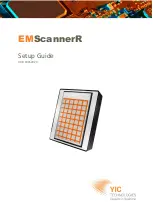
26
Preparation of the fiberscope
Příprava fibroskopu
Vorbereitung des Fiberskopes
3
WARNUNG:
Bevor das Fiberskop aus dem
Patienten entfernt wird, muss der Lock
Mechanismus
gelöst und die distale
Spitze des Fiberskopes in die neutrale,
nicht abgewinkelte Position gebracht
werden, da sonst Schäden am Instru ment
oder Verletzungen des Patienten auftreten
können.
Zum Lösen der Fixierung drehen Sie den Lock
Mechanismus
langsam nach proximal zurück.
3
WARNING:
Before the fiberscope is
removed from the patient, the locking
mechanism
must be released and
the distal tip of the fiberscope put in the
neutral, nondeflected position. Otherwise
the instrument may be damaged or the
patient injured.
To release the locking mechanism
from the
secure position, turn it slowly to proximal.
10.3
Absaugung
Durch Drücken des Absaugventils
kann (bei
angeschlossener und eingeschalteter Saug pumpe)
die Absaugung ausgelöst werden.
2
VORSICHT:
Während der Absaugung
soll sich kein Instrument im Absaugkanal
befinden. Der Einlass des Instrumenten
kanals sollte verschlossen sein, damit keine
Nebenluft gezogen wird.
10.4
Insufflation
In der Anästhesie O
2
Schlauch am Instrumenten
kanal anschließen:
• mit Schlaucholive (Art.Nr. 600007) am
Instrumentenkanal oder
• falls Sie den Dreiwege DoppelhahnAdapter
mit LUERLock (Art.Nr. 6927691) verwenden,
den Schlauch auf die Schlauchhalterung am
abgewinkelten Teil des Adapters aufstecken.
Dadurch bleibt der geradlinige Durchlass des
Adapters zur Instrumentrierung frei.
10.5
Fokussierung
Die Scharfstellung des Bildes erfolgt am
Fokusring
.
1
HINWEIS:
Beim Anschluss der von
KARL STORZ empfohlenen Foto oder
Videosysteme muss sich der Fokusring
(falls voranden) des Fiberskopes in
Nullstellung (Markierung) befinden.
Bei DCI
®
Fiberskopen erfolgt die Fokusierung am
Einstellrad der DCI
®
Kamera (s. Seite 28).
10.3
Suction
Press the suction valve
to start suction (when
the suction pump has been connected and
switched on).
2
CAUTION:
There should be no instrument
in the suction channel during suction. The
instrument channel inlet should be closed
so that no secondary air is drawn in.
10.4
Insufflation
Under anesthesia, connect the O
2
hose to the
instrument channel:
•
using a barbed tube (Art. no. 600007) on the
instrument channel or
• if you are using the threeway double stopcock
adapter with LUERLock (Art. no. 6927691),
attach the hose to the tube holder on the
angled part of the adapter. This ensures that the
straightline passage of the adapter remains free
for instrument insertion.
10.5
Focusing
The image is focused with the focusing ring
.
1
NOTE:
When connecting photo or video
systems recommended by KARL STORZ,
the fiberscope focusing ring must be at the
zero position (mark).
DCI
®
fiberscopes are focused using the adjustment
wheel of the DCI
®
camera (see page 28).
DCI
®
3
VÝSTRAHA:
Před odstraněním fibroskopu
z pacienta musíte uzavírací mechanismus
uvolnit a distální hrot fibroskopu uvést
do neutrální, nezaúhlené polohy, jinak by
mohlo dojít k poškození nástroje nebo
poranění pacienta.
Pro uvolnění fixace pomalu otáčejte uzavíracím
mechanismem
proximálně zpět.
10.3
Odsávání
Stisknutím odsávacího ventilu
lze (v případě
připojeného a zapnutého odsávacího čerpadla)
spustit odsávání.
2
POZOR:
Během odsávání se v odsávacím
kanálu nesmí nacházet žádný nástroj.
Přívod instrumentálního kanálu by měl být
uzavřený, aby nebyl nasáván sekundární
vzduch.
10.4
Insuflace
Při anestezii připojte hadičku na O
2
k
instrumentálnímu kanálu.
•
pomocí hadicové olivy (obj. č. 600007) k
instrumentálnímu kanálu nebo
•
pokud používáte adaptér trojcestného kohoutu
s LUERLock (obj. č.Nr. 6927691), nasaďte
hadici na držák v zahnuté části adaptéru. Tak
zůstane rovný průtok adaptéru k nástrojům
volný.
10.5
Zaostření
Nastavení ostrosti obrazu se provádí v
zaostřovacím kroužku
.
1
UPOZORNĚNÍ:
Při připojení foto nebo
videosystémů doporučených společností
KARL STORZ musí být zaostřovací kroužek
fibroskopu (jeli k dispozici) v nulové poloze
(značení).
U fibroskopů DCI
®
se zaměřování provádí na
nastavovacím kolečku kamery DCI
®
(viz str. 28).
















































